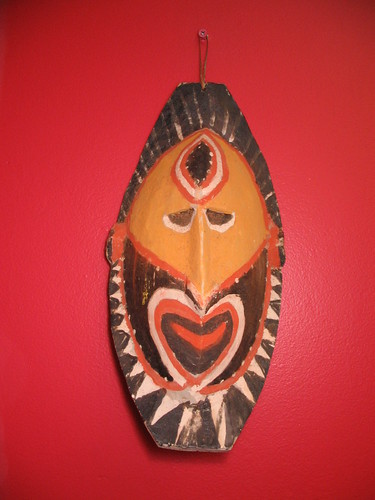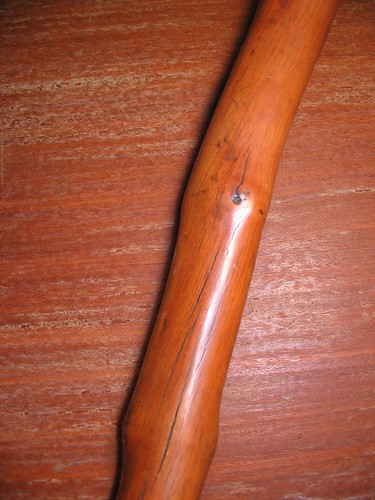Lost
Over the Christmas holidays I acquired a small collection of artefacts from the highlands of New Guinea.
A distant relative of mine (specifically my father’s brother’s wife’s adoptive mother’s sister) was, apparently, a missionary in New Guinea in the 1960s and 70s. When she retired in the 1980s, she donated some souvenirs from her travels to the local Baptist school in my home town.
Twenty years later, the school decided to disencumber itself of the collection. The only member of my extended family who showed even a slight interest in them was my father… and that was largely because he lives close to the school. The collection was boxed up and he put it all, more or less sight unseen, in one of his sheds, and mentioned to me that I could go through it all and see if there was anything I wanted.
I spent a couple of hours in the shed, unpacking the boxes and trying not to break anything.
Some of the items were pure tourist kitsch; a dark skinned plastic doll dressed in native costume, Barbie-sized model spears and bows, and little handbags made from plastic beads and fishing line. But others items seemed more authentic. There were some polished seed and shell necklaces on strings that had clearly been hand-twined from grass fibres. There were spears of half a dozen varieties; some simple, some intricately constructed. There were delicate grass skirts, and primitive axe heads hewn from local stone.
The most arresting items were the masks.


How authentic are these masks, I wonder? They’re roughly hewn, and they’re coloured with natural pigments that flake off if you so much as look at them too roughly. That would seem to suggest a certain amount of authenticity.
On the other hand, exactly what purpose could they serve other than as objects to sell to tourists? They’re not really “masks”, since there’s no way of wearing them. They have a little loop of dried grass that allows them to be hung on a wall, but do New Guinea highlanders even have walls? Do objects such as these have any genuine purpose within the culture that created them?
The stone axes were even more problematic.

If you were going to produce souvenirs for tourists, would you go to all the effort of hewing an axe, or would you just weave up some placemats or carve a cute little animal out of some scrap wood?
In addition, the handle is wonderfully smooth and polished, undulating with the contours of the wood. It obviously hasn’t been sandpapered; it’s just been used. A lot.

What I may have here is a collection of artefacts made by genuine New Guinea tribespeople, using the same skills and methods that their ancestors used. However, the artefacts may not necessarily have been created for use by the tribe, but for sale to outsiders.
Either way, they’re evocative pieces. I’ve advised my parents to keep anything they want, then seek the counsel of the state museum to determine if the remainder has any heritage value, and donate it accordingly.
A distant relative of mine (specifically my father’s brother’s wife’s adoptive mother’s sister) was, apparently, a missionary in New Guinea in the 1960s and 70s. When she retired in the 1980s, she donated some souvenirs from her travels to the local Baptist school in my home town.
Twenty years later, the school decided to disencumber itself of the collection. The only member of my extended family who showed even a slight interest in them was my father… and that was largely because he lives close to the school. The collection was boxed up and he put it all, more or less sight unseen, in one of his sheds, and mentioned to me that I could go through it all and see if there was anything I wanted.
I spent a couple of hours in the shed, unpacking the boxes and trying not to break anything.
Some of the items were pure tourist kitsch; a dark skinned plastic doll dressed in native costume, Barbie-sized model spears and bows, and little handbags made from plastic beads and fishing line. But others items seemed more authentic. There were some polished seed and shell necklaces on strings that had clearly been hand-twined from grass fibres. There were spears of half a dozen varieties; some simple, some intricately constructed. There were delicate grass skirts, and primitive axe heads hewn from local stone.
The most arresting items were the masks.


How authentic are these masks, I wonder? They’re roughly hewn, and they’re coloured with natural pigments that flake off if you so much as look at them too roughly. That would seem to suggest a certain amount of authenticity.
On the other hand, exactly what purpose could they serve other than as objects to sell to tourists? They’re not really “masks”, since there’s no way of wearing them. They have a little loop of dried grass that allows them to be hung on a wall, but do New Guinea highlanders even have walls? Do objects such as these have any genuine purpose within the culture that created them?
The stone axes were even more problematic.

If you were going to produce souvenirs for tourists, would you go to all the effort of hewing an axe, or would you just weave up some placemats or carve a cute little animal out of some scrap wood?
In addition, the handle is wonderfully smooth and polished, undulating with the contours of the wood. It obviously hasn’t been sandpapered; it’s just been used. A lot.

What I may have here is a collection of artefacts made by genuine New Guinea tribespeople, using the same skills and methods that their ancestors used. However, the artefacts may not necessarily have been created for use by the tribe, but for sale to outsiders.
Either way, they’re evocative pieces. I’ve advised my parents to keep anything they want, then seek the counsel of the state museum to determine if the remainder has any heritage value, and donate it accordingly.


0 Comments:
Post a Comment
<< Home